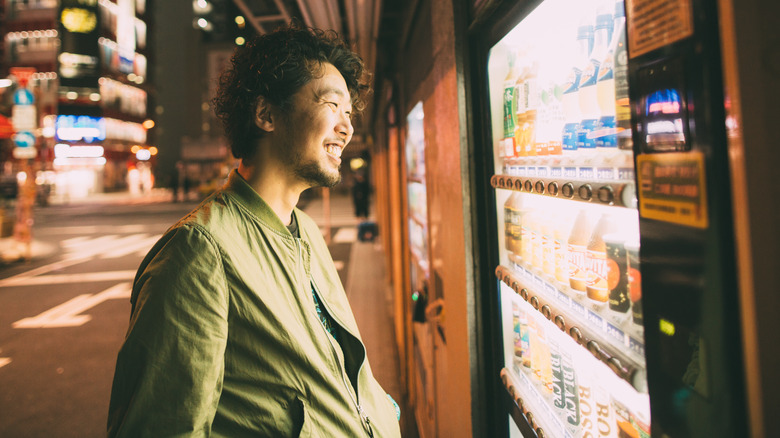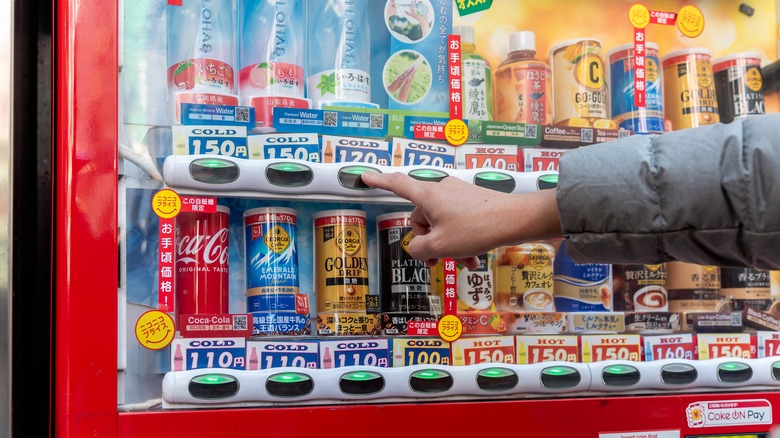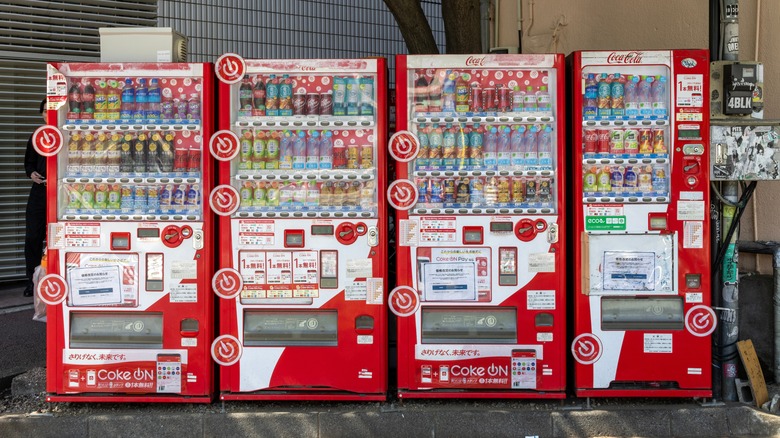Why Tourists Shouldn't Ignore The Blue And Red Colors On A Vending Machine In Japan
If you've ever used a faucet with handles marked blue and red for "cold" and "hot," then congratulations — you've just mastered the art of buying drinks from a vending machine in Japan. This could take first-time visitors in Tokyo (or anyone unaccustomed to hot vending-machine drinks) by surprise. In traditional Japanese vending machines, where you're looking through a window at sample bottles and cans, a blue label above the button means it's a cold drink. Red means hot, though you might not even see that color when traveling here in the summer. The drinks on offer tend to correspond to the season, with machines always selling some cold drinks but also rotating in hot ones during the fall and winter.
Certain machines will spell it out for you as clear as day in English, with labels above the drink price reading "Cold" and "Hot." Others may write it in Japanese, with the blue つめたい (tsumetai) denoting cold and the red あたたかい (atatakai) denoting warm or hot. Newer vending machines with a digital display might just show a blue or red circle next to the price.
Forget about the U.S. electoral map; these drinks and their colors are apolitical. This isn't "The Matrix," either, so you don't have to worry about the simulation breaking down as a hot red drink awakens you to the falseness of perceived reality. Then again, your mind could theoretically be dream-vacationing in Japan while your body is being harvested as a human battery for artificially intelligent vending machines.
Red means hot and blue means cold
If you're totally color-blind and reading Japanese is a no-go, you can use your phone camera through the Google Translate app to decode the finer points of drink bottles, cans, and vending machine labels. This iPhone hack translates restaurant menus with no app necessary, and you could also use it on vending-machine drinks. It helps to know what kind of tea or coffee you're buying and whether it's the kind Oscar-winning actor Tommy Lee Jones has been plugging in the latest Boss Coffee commercial. As long as you can differentiate between blue and red, choosing a cold or hot drink shouldn't be any more complicated than working color-coded faucet handles.
Again, if you're visiting Japan in the summer, you might walk around and never see a vending machine with hot drinks. Just as an experiment, I took a visual inventory of all the machines I encountered on the street this morning on my way to the coffee shop in the suburbs of Tokyo. They were all selling cold blue drinks exclusively because it's June as I write this, and the season of summer festivals and fireworks is near. Yet, I know from living here for 14 years that when the seasons change and it gets cold again, those machines will free up some of their space for lines of hot red drinks. The drinks, sometimes scalding hot, also provide a makeshift way to warm your hands when it's freezing cold outside in winter.
Other things to know about Japanese vending machines
It's not uncommon for vending machines in Japan to reject the new anti-counterfeit coins and bills issued by the country's central bank every 20 years or so. As The New York Times notes, the fresh 500-yen coin (which entered circulation in November 2021) was still only recognized by about 30% of machines by mid-2023. Having the machine spit your new-fangled, silver-centered, 500-yen coin back out could also happen in a ramen shop or on the bus. Unfortunately, many machines aren't ready for the Bank of Japan's new July 2024 series of bills, either.
Despite the rejected coins, the Land of the Rising Sun still feels like the Land of the Dispensed Drinks at times. Everywhere you turn, there seems to be a vending machine or multiple machines standing in a row as if they're all hungry for loose cash. Around 4 million such machines are scattered across Japan, which is actually about a million less than there were in the early 2010s.
Even as their numbers decrease in proportion to the population decline nationwide, there are still more vending machines here than convenience stores, which is saying a lot. This is the country with the most 7-Elevens in the world, and Japan's 7-Elevens are also a sweet paradise for iced coffee-loving tourists. If you're a budget traveler, remember that buying a drink at the convenience store or supermarket can be cheaper than buying the same brand from a vending machine.


